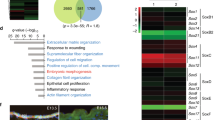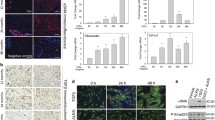Abstract
Wound healing consists of sequential steps of tissue repair, and cell migration is particularly important. In order to analyze the potential function of growth arrest and DNA damage inducible protein 34 (GADD34) in tissue repair, we performed in vitro and in vivo wound healing experiments. In an in vitro scratch assay, GADD34 knockout (KO) mouse embryonic fibroblasts (MEFs) had higher migration rates than did wild type (WT) MEFs. Furthermore, the rate of wound closure was faster in GADD34 KO MEFs than in WT MEFs. Using in vivo punch biopsy assays, GADD34 KO mice had accelerated wound healing compared to WT mice. WT mice expressed higher amounts of myosin IIA in migrating macrophages and myofibroblasts than did GADD34 KO mice. These results indicate that GADD34 negatively regulates cell migration in wound healing via expression of myosin IIA.





Similar content being viewed by others
References
Betapudi V, Licate LS, Egelhoff TT (2006) Distinct roles of nonmuscle myosin II isoforms in the regulation of MDA-MB-231 breast cancer cell spreading and migration. Cancer Res 66:4725–4733
Bresnick AR (1999) Molecular mechanisms of nonmuscle myosin-II regulation. Curr Opin Cell Biol 11:26–33
Brush MH, Shenolikar S (2008) Control of cellular GADD34 levels by the 26S proteasome. Mol Cell Biol 28:6989–7000
Even-Ram S, Doyle AD, Conti MA, Matsumoto K, Adelstein RS, Yamada KM (2007) Myosin IIA regulates cell motility and actomyosin microtubule crosstalk. Nat Cell Biol 9:299–309
Gupton SL, Waterman-Storer CM (2006) Spatiotemporal feedback between actomyosin and focal-adhesion systems optimizes rapid cell migration. Cell 125:1361–1374
Han AP, Yu C, Lu LR et al (2001) Heme-regulated eIF2 alpha kinase (HRI) is required for translational regulation and survival of erythroid precursors in iron deficiency. EMBO J 20:6909–6918
Harding HP, Zeng HQ, Zhang YH, Jungries R, Chung P, Plesken H, Sabatini DD, Ron D (2001) Diabetes mellitus and exocrine pancreatic dysfunction in Perk-/- mice reveals a role for translational control in secretory cell survival. Molecular Cell 7:1153–1163
He B, Gross M, Roizman B (1998) The gamma(1)34.5 protein of herpes simplex virus 1 has the structural and functional attributes of a protein phosphatase I regulatory subunit and is present in a high molecular weight complex with the enzyme in infected cells. Journal of Biological Chemistry 273:20737–20743
Kojima E, Takeuchi A, Haneda M et al (2003) The function of GADD34 is a recovery from a shutoff of protein synthesis induced by ER stress—elucidation by GADD34-deficient mice. Faseb Journal 17:1573–1575
Kolega J (2006) The role of myosin II motor activity in distributing myosin asymmetrically and coupling protrusive activity to cell translocation. Mol Biol Cell 17:4435–4445
Lauffenburger DA, Horwitz AF (1996) Cell migration: a physically integrated molecular process. Cell 84:359–369
Lo CM, Buxton DB, Chua GCH, Dembo M, Adelstein RS, Wang YL (2004) Nonmuscle myosin IIB is involved in the guidance of fibroblast migration. Mol Biol Cell 15:982–989
Martin P (1997) Wound healing—aiming for perfect skin regeneration. Science 276:75–81
Mengesdorf T, Althausen S, Oberndorfer I, Paschen W (2001) Response of neurons to an irreversible inhibition of endoplasmic reticulum Ca2+-ATPase: relationship between global protein synthesis and expression and translation of individual genes. Biochem J 356:805–812
Morin NA, Oakes PW, Hyun YM et al (2008) Nonmuscle myosin heavy chain IIA mediates integrin LFA-1 de-adhesion during T lymphocyte migration. J Exp Med 205:195–205
Novoa I, Zeng HQ, Harding HP, Ron D (2001) Feedback inhibition of the unfolded protein response by GADD34-mediated dephosphorylation of eIF2 alpha. J Cell Biol 153:1011–1021
Novoa I, Zhang YH, Zeng HQ, Jungreis R, Harding HP, Ron D (2003) Stress-induced gene expression requires programmed recovery from translational repression. EMBO J 22:1180–1187
Oh-Hashi K, Maruyama W, Isobe K (2001) Peroxynitrite induces GADD34, 45, and 153 VIA p38 MAPK in human neuroblastoma SH-SY5Y cells. Free Radic Biol Med 30:213–221
Pollard TD, Borisy GG (2003) Cellular motility driven by assembly and disassembly of actin filaments. Cell 112:453–465
Saez CG, Myers JC, Shows TB, Leinwand LA (1990) Human nonmuscle myosin heavy-chain messenger-RNA-generation of diversity through alternative polyadenylylation. Proc Natl Acad Sci USA 87:1164–1168
Sen CK, Khanna S, Babior BM, Hunt TK, Ellison EC, Roy S (2002) Oxidant-induced vascular endothelial growth factor expression in human keratinocytes and cutaneous wound healing. J Biol Chem 277:33284–33290
Zhao H, Spitz MR, Tomlinson GE, Zhang HF, Minna JD, Wu XF (2001) gamma-radiation-induced G(2) delay, apoptosis, and p53 response as potential susceptibility markers for lung cancer. Cancer Res 61:7819–7824
Acknowledgments
We thank M. Tanaka for technical assistance with confocal imaging. This work was supported by the Ministry of Education, Science, Technology, Sports and Culture, Japan
Author information
Authors and Affiliations
Corresponding author
Rights and permissions
About this article
Cite this article
Tanaka, C., Ito, S., Nishio, N. et al. GADD34 suppresses wound healing by upregulating expression of myosin IIA. Transgenic Res 19, 637–645 (2010). https://doi.org/10.1007/s11248-009-9347-z
Received:
Accepted:
Published:
Issue Date:
DOI: https://doi.org/10.1007/s11248-009-9347-z




